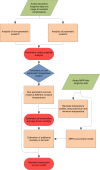Modelling adult Aedes aegypti and Aedes albopictus survival at different temperatures in laboratory and field settings
- PMID: 24330720
- PMCID: PMC3867219
- DOI: 10.1186/1756-3305-6-351
Modelling adult Aedes aegypti and Aedes albopictus survival at different temperatures in laboratory and field settings
Abstract
Background: The survival of adult female Aedes mosquitoes is a critical component of their ability to transmit pathogens such as dengue viruses. One of the principal determinants of Aedes survival is temperature, which has been associated with seasonal changes in Aedes populations and limits their geographical distribution. The effects of temperature and other sources of mortality have been studied in the field, often via mark-release-recapture experiments, and under controlled conditions in the laboratory. Survival results differ and reconciling predictions between the two settings has been hindered by variable measurements from different experimental protocols, lack of precision in measuring survival of free-ranging mosquitoes, and uncertainty about the role of age-dependent mortality in the field.
Methods: Here we apply generalised additive models to data from 351 published adult Ae. aegypti and Ae. albopictus survival experiments in the laboratory to create survival models for each species across their range of viable temperatures. These models are then adjusted to estimate survival at different temperatures in the field using data from 59 Ae. aegypti and Ae. albopictus field survivorship experiments. The uncertainty at each stage of the modelling process is propagated through to provide confidence intervals around our predictions.
Results: Our results indicate that adult Ae. albopictus has higher survival than Ae. aegypti in the laboratory and field, however, Ae. aegypti can tolerate a wider range of temperatures. A full breakdown of survival by age and temperature is given for both species. The differences between laboratory and field models also give insight into the relative contributions to mortality from temperature, other environmental factors, and senescence and over what ranges these factors can be important.
Conclusions: Our results support the importance of producing site-specific mosquito survival estimates. By including fluctuating temperature regimes, our models provide insight into seasonal patterns of Ae. aegypti and Ae. albopictus population dynamics that may be relevant to seasonal changes in dengue virus transmission. Our models can be integrated with Aedes and dengue modelling efforts to guide and evaluate vector control, better map the distribution of disease and produce early warning systems for dengue epidemics.
Figures





References
Publication types
MeSH terms
Grants and funding
LinkOut - more resources
Full Text Sources
Other Literature Sources

